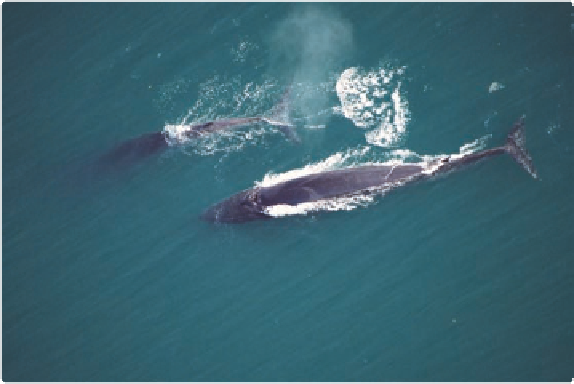Travel Reference
In-Depth Information
equipment onboard his catamaran, and only takes
small groups to ensure minimum disturbance.
Because the tours form part of an “Education
and Research” programme, you may also share
the trip with student researchers gathering
valuable marine data, which contributes towards
the assessment of what impacts like boat traffic,
unsustainable fishing practices and pollution have
on the animals in Irish waters.
053 whale-watChiNG iN CoRk
The sheer thrill of sitting in a boat within a
belly flop of a forty-tonne animal is what whale-
watching is all about. If you're lucky, you may
see one breach the water and flip its tail-fluke
over in a sweeping arc before slapping it back
down with a crashing thump. Naturally tour
guide Nic Slocum won't guarantee that you'll
see this display on one of his wildlife boat-tours
off the southwest of Ireland, but with a viewing
success rate of over eighty percent, your chances
of seeing a whale up close with him are good.
Depending on the conditions, Nic's boat tours go
past the Old Head of Kinsale or west beyond Cape
Clear to the Fastnet Rock. The waters of West
Cork are a popular summer feeding ground: on a
good day you'll see several species of marine life, of
which the most common are minke whales (May-
Dec), fin whales (June-Jan) and humpback whales
(Aug-Jan), while common dolphins and harbour
porpoises can be seen all year round. There's also
a chance you'll see killer whales, long-finned pilot
whales and white-beaked dolphins.
Nic is a marine zoologist and a passionate
marine conservationist; he operates his tours in
accordance with guidelines proposed by the Irish
Whale and Dolphin Group and the National Parks
and Wildlife Service. He provides interactive
commentaries using hydrophone and camera
Need to know
Tours run up to three times daily
in summer, leaving from Reen pier at Castlehaven
harbour, West Cork. For sightings info, rates and
booking details see
W
www.whalewatchwestcork.
com;
T
+353 (0) 283 3357. Irish Whale and
Dolphin Group:
W
www.iwdg.ie.
054 See the liGht oN SaRk
On a clear night, you can use the full moon
to guide you across the narrow isthmus that
connects Little Sark to the main island. And
there won't be a city light in sight. Sark
is the sort of place you'll probably end up
recommending to anyone visiting the Channel
Islands. It's the smallest and most unspoilt of
the four main islands, and the only access is by
ferry from Guernsey, so there are no cars - just
a few tractors, bikes and horse-drawn carriages,
the latter two available to hire.
The pick of several stunning beaches is the
gloriously sandy cove at Le Grande Grêve, one of
the most unspoilt in the Channel Islands. It's a
small secluded bay flanked by steep cliffs, so you
can enjoy a sheltered swim while the kids potter
among rock pools and caves.
There are only a few places to stay on the
island. The smart La Sablonnerie Hotel (the
only place to stay and eat on Little Sark) serves
produce from the hotel's own farm and gardens.
You can also camp at La Valette campsite on the
east side of the main island, where there are
solar-powered showers. Because of the limited
choice of accommodation, the island never gets
crowded: that's part of its charm. Perhaps you
shouldn't tell anyone about it.
Fin whales
























Search WWH ::

Custom Search